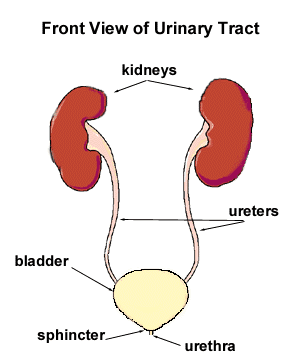Kidney Stones In Children
What is stone disease?

Stone disease describes a condition in which solutes normally found in the urine, such as calcium and uric acid, come together in high concentration to form what's called "stones" in the urinary tract. They cause pain by creating an obstruction of the drainage of the urine.
Stones are not common in children, but do occur and may present a difficult treatment problem. There are many minimally invasive methods for removing kidney stones, but few that are designed for children. Stones may cause problems anywhere in the urinary tract, from the kidney to the ureter and into the bladder. Most of the time, they are in the kidney or ureter.
What causes stone disease?
Stones form because there is too much of the ingredients of the stone and not enough water in the urine. This can occur either because there is an abnormally high amount of stone-forming material in the urine, or the urine is too concentrated because of dehydration.
In children, stone disease is far less common than it is in adults. Many of the children who form urinary stones have an underlying abnormality or the urinary tract. These can include obstructions of the kidney and ureter, or diseases such as spina bifida.
What are the symptoms of stone disease?
The symptoms of stone disease include pain or blood in the urine (hematuria), fever, nausea and/or vomiting.
How is stone disease diagnosed?
Depending on the location of the stones, children may experience symptoms described above, particularly if the stones are in the ureteropelvic junction or in the ureter. In that case, your child's doctor will see the stones on an x-ray. However, stones in children are often diagnosed as a result of x-rays done for other reasons.
How is stone disease treated?
Children can pass stones that are relatively large as compared to adults. At times, however, it is necessary to remove the stones; this is based on pain, nausea and vomiting, fever, or any other marked change in the child's condition that may be due to the stone. It is also appropriate to remove a stone that is growing so that it may be removed more easily, rather than waiting until it is very large.
The usual methods to remove a kidney stone in children include extracorporeal shock wave lithotripsy (ESWL), percutaneous nephrolithotomy (PCNL), ureteroscopy, or open stone surgery. The choice of technique depends upon the location, size and type of stone, as well as the child's medical condition and anatomy. All methods are possible in children.
ESWL is also known as the "stone bath" because the initial machines that were used involved having the patient lie in a water bath to permit passage of shock waves. The method is based on focusing shock waves from a generator outside the body through the skin to reach the stone in the kidney or ureter. This is like focusing sunlight through a magnifying lens to create enough heat to burn. If you place your hand in the beam close to the lens it will not even feel warm as the light rays are not focused, but at the point where they are focused, they can burn paper. The shock waves are focused so that they are intense at the position of the stone, but are more spread out at the level of the skin and therefore do not do any damage to the skin. The positions of the stone and shock waves are controlled using ultrasound or x-ray guidance. Many shock waves are applied slowly, often several thousand, over about 20 minutes. In older children this may permit use of sedation to control discomfort, but in small children, general anesthesia is used. The stone is fragmented and the pieces will pass over the following days. It may take up to 3 months for all fragments to pass, and this depends upon the position of the stone. The overall success rate of ESWL is about 85%. Stones in the lower pole of the kidney are less likely to pass. Very hard stones such as those made of cystine or certain kinds of calcium stones, may not fragment very well.
Percutaneous nephrolithotomy (PCNL) is a technique in which a needle is used to puncture the kidney under ultrasound or x-ray guidance and an instrument is passed into the kidney to allow direct examination, fragmentation and removal of a stone. This technique requires the patient to be completely asleep. A kidney drainage tube is usually left in place for 2 to 4 days, and removed in the office. PCNL is particularly useful in a patient with a hard stone that might not fragment with ESWL or in whom the anatomy of the kidney is not normal. In those children, fragmented stones may not pass effectively. If a stone has created a serious obstruction, a kidney drainage tube (nephrostomy) may have already been placed and this may be used to remove the stone. Stones may be removed using this technique all the way to the bladder. In small children, the size of the tube used for access to the kidney must be adapted to the child's size. A special, small percutaneous access sheath has been developed here to permit access to the kidney for stone removal in small children. This system is very useful for small and moderate stones, but less so for large stone (>2.0 cm).
Print PageContact us to request an appointment or ask a question. We're here for you.




